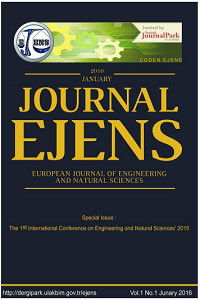The Effects of Hydrogen Peroxide and Sodium Hypochlorite Oxidizing Treatments on the Color Properties of Naturally Colored Green Cotton
The Effects of Hydrogen Peroxide and Sodium Hypochlorite Oxidizing Treatments on the Color Properties of Naturally Colored Green Cotton
___
- [1]. Vreeland, J. and James, M. (1999). The revival of colored cotton. Scientific America, 280 (4), 112-119
- [2]. Lee, J. (1996). A new spin on naturally colored cotton. Agricultural Research 44 (4), 20-21
- [3]. Mohammadioun, M., Gallaway, M. and Apodaca, J. K. (1994). An economic analysis of organic cotton as a niche crop in texas. University of Texas at Austin, Bureau of Business Research, Austin, Texas
- [4]. Burnett, P., 1995, Cotton naturally, Textile Horizons, Vol.15, February, pp 36–38
- [5]. Robbins, J. Destination Discovery 1994, 18–21, Khadi, B. M.; Kulkarni, V. N. Indian Text J 1996, 106(11), 72–76
- [6]. Lee, J. Agric Res 1996, 44, 20–21, Elesini, U. S.; Richards, A. F.; Rowe, T. Proceedings 30th International Symposium on Novelties in Textiles, Ljubljana, 1996, pp 122–125
- [7]. Kohel, R. Crop Sci 1985, 25, 793–797, Fox, S. V. Proceedings: Sixth Annual Engineered Fiber Selection Conference, May 3–5, 186–189
- [8]. Williams, B. L.; Horridge, P. Text Tech Int 1997, 31–36
- [9]. VanZandt, M. J.; Horridge, P.; Dever, J. K. Clothing Text Res J 1997, 15(4), 246–251
- [10]. Chen, H. L., & Yokochi, A. (2000). X‐ray diffractometric study of microcrystallite size of naturally colored cottons. Journal of Applied Polymer Science, 76(9), 1466-1471.
- [11]. Matusiak M, Frydrych I. Investigation of Naturally Coloured Cotton of Different Origin – Analysis of Fibre Properties, FIBRES & TEXTILES in Eastern Europe 2014; 22, 5(107): 34-42
- [12]. Kimmel, L.B. and Day, 2001, M.P., AATCC Rev., 1(10), 32, 2001
- [13]. Ryser, U., Cotton fiber initiation and histodifferentiation, in Cotton Fibers, Developmental Biology, Quality Improvement, and Textile Processing, Basra, A.S., Ed., Haworth Press, Binghamton, New York, 1999, chap. 1, pp. 21–29
- [14]. Ryser, U., Meier, H., & Holloway, P. J. (1983). Identification and localization of suberin in the cell walls of green cotton fibres (Gossypium hirsutum L., var. green lint). Protoplasma, 117(3), 196-205.
- [15]. Elesini, U. S., Cuden, A. P., & Richards, A. F. (2002). Study of the green cotton fibres. Acta Chim. Slov, 49, 815-833.
- [16]. P Singh, V V Singh, V. N Waghmare, Naturally Coloured Cotton, CICR Technical Bulletin NO: 4, http://www.cicr.org.in/pdf/naturally_colored_cotton.pdf
- [17]. Karmakar, S. R. (1999). Chemical technology in the pre-treatment processes of textiles (Vol. 12). Elsevier.
- [18]. Sho Yeung Kang, Helen H. Epps. (2009) Effect of scouring and enzyme treatment on moisture regain percentage of naturally colored cottons. Journal of the Textile Institute 100:7, pages 598-606.
- [19]. Osman Çağırgan, Ayhan Barut, “Nazilli Pamuk Araştırma Enstitüsündeki Genetik-Stok Pamuk Çeşitlerinin Özellikleri”, T.C. Tarım ve Köyişleri Bakanlığı Tarımsal Araştırmalar Genel Müdürlüğü Nazilli Pamuk Araştırma Enstitüsü Müdürlüğü, Yayın No:58, Nazilli, 2000, page 30.
- [20]. Avinc, O., & Yavas, A. (2017). Soybean: For Textile Applications and Its Printing. In Soybean-The Basis of Yield, Biomass and Productivity. InTech.
- [21]. Sho Yeung Kang; Epps, Helen H., Effect of Scouring on the Color of Naturally-colored Cotton and the Mechanism of Color Change, AATCC Review. Jul 2008, Vol. 8 Issue 7, p38-43. 6p
- Başlangıç: 2015
- Yayıncı: CNR Çevre
Sinan Melih Nigdeli, Gebrail Bekdaş, Aikerim Aydın
Characteristics of Some Turkish Lignites and Potential of Using in Agricultural Sector
Ali Serkan SOYDAN, Arzu YAVAŞ, Osman Ozan AVİNÇ, Gizem Karakan GÜNAYDIN, M. Niyazi KIVILCIM, Mehmet DEMİRTAŞ, Sema Palamutcu
Shape Features Based Conic Arcs for Unclassified Wheat Identification
Kemal ÖZKAN, Ahmet Okan ONARCAN, Erol SEKE, Murat OLGUN
Numerical Investigation of Hot Ultrasonic Assisted Turning of Titanium Alloy
Recent advances in membrane fouling control in wastewater treatment processes
Amar CEMANOVİC, Neslihan MANAV, Abdullah KIZILET, Özer ÇINAR
Toygun Dağdevir, Orhan Keklikcioglu, Veysel Ozceyhan
Macro and Micro Modeling of the Unreinforced Masonry Shear Walls
